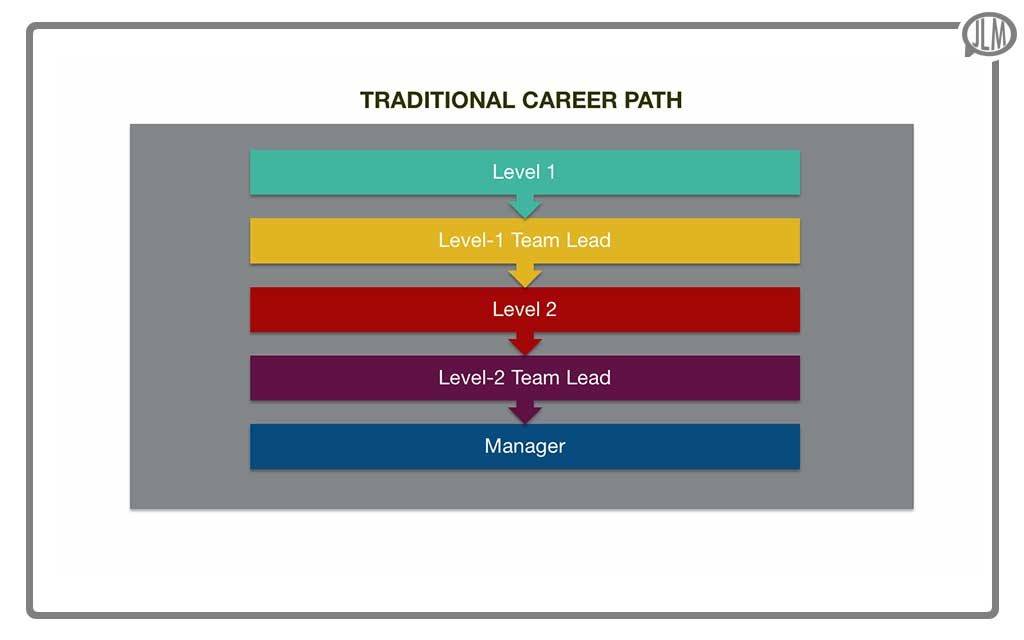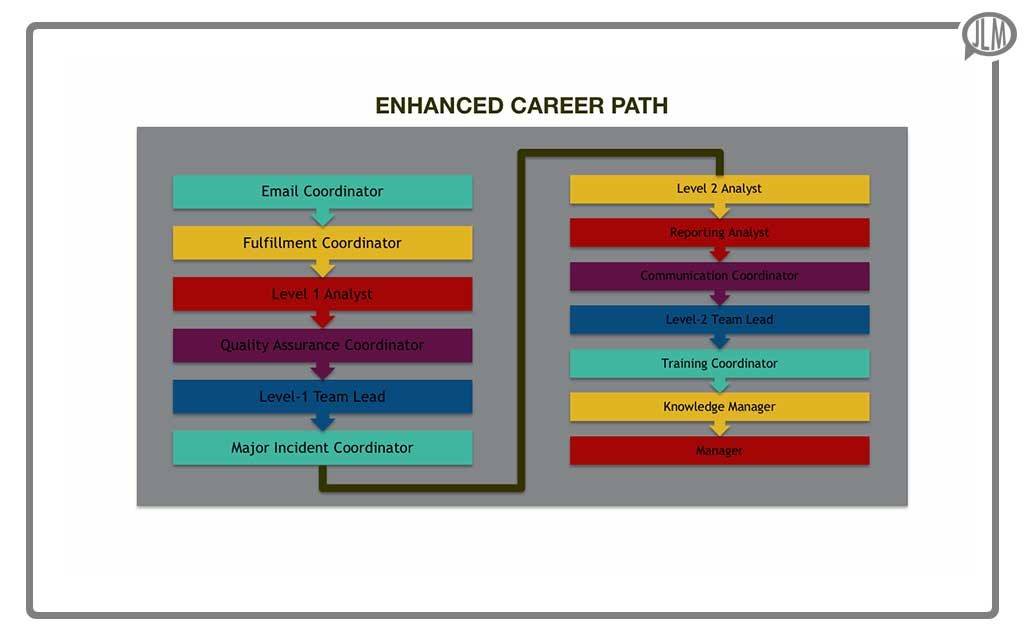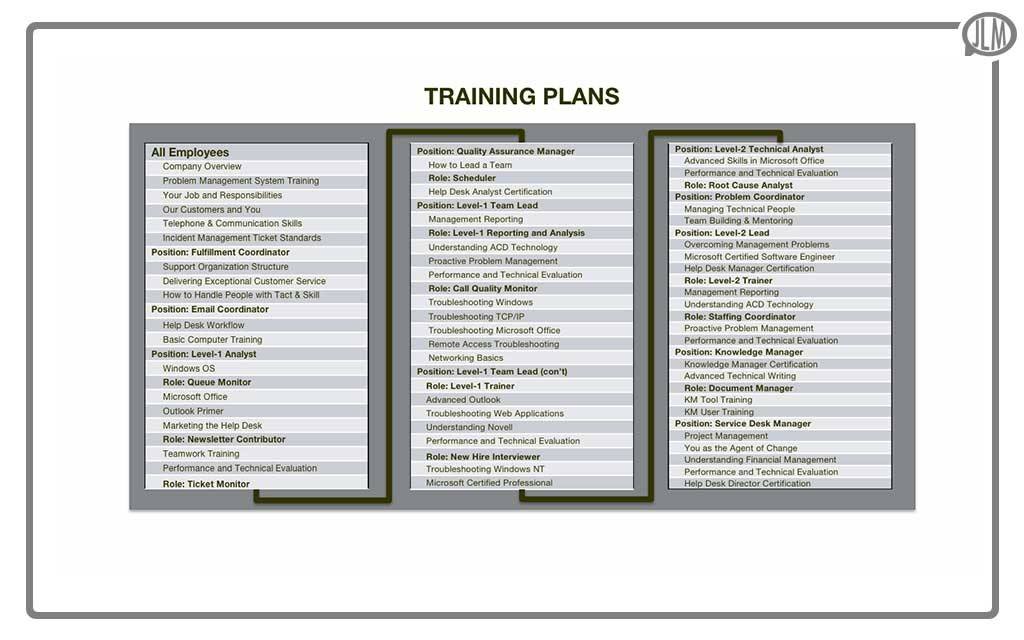![]()
In any support organization, it is important to develop a defined career path. The career path sets expectations with staff on what opportunities are available for growth within the organization. Most employees will want to develop their skills and grow their potential over time. If growth opportunities are not available, the career-motivated employees will seek out opportunities with other companies.
Pathing Even in Flat Organizations
No matter how flat the organization, a career path can be achieved successfully. A traditional career path is one that provides the opportunity for an employee to move from position to position taking on new roles and responsibilities with an increase in compensation to match the position’s defined responsibilities. An example of this is depicted in Figure 1. A new employee will join an organization at Level 1 and work their way to a team leader. From there, they might be promoted into Level 2 and maybe even eventually become team leader again. The next logical position is to replace the manager or supervisor.

Figure 1 – Traditional Career Path
This type of career path can provide a clear path of promotion. However, in organizations with low turnover, the traditional career path may take many years, and in some cases, there may be little opportunity for advancement. Limited career growth will eventually lead to low motivation and morale of those staff that seeks new challenges and opportunities.
In organizations such as call centers, the organization is viewed as primarily flat. With all customer support representatives reporting to a supervisor, there is little or no opportunity to create a career path. In these environments, there may be ratios of 100 or more representatives to one supervisor. It is difficult to develop a career path for so many employees when there is only one logical position to move to in a promotion.
Managers must develop creative ways to provide advancement opportunity to staff. Management can add new positions to the traditional career path, break down the responsibilities of the organization, and use the inventory of responsibilities to develop a career path.
Add New Positions
One way to create a career path is to identify new positions within the environment. Depending on the size of your organization, the manager can add new positions including
- Quality Assurance Coordinator
- Major Incident Coordinator
- Knowledge Manager
- Email Coordinator
- Fulfillment Coordinator
- Communication Coordinator
- Reporting Analyst Trainer
Different positions within the support organization can create a much more robust career path that moves an employee through increasingly more difficult roles before reaching the final goal of a supervisor or manager. The enhanced career path would look like the path defined in Figure 2.

Figure 2 – Enhanced Career Path
Define Responsibilities
After defining positions, the career path can be further enhanced by also identifying additional responsibilities. Additional responsibilities could be defined as:
- Scheduling
- Queue management
- Root Cause & Trend Identification
- Major Incident Communication Coordination
- Service Level Management
- Staffing
- Document maintenance
- New hire interviews
- Call monitoring
- Ticket review
- Solution testing
- FAQ creation
- Customer newsletter
- Incident closure
- Technical Support Partner liaison
The possibilities are endless and can be determined by the unique needs of your support organization structure, technologies, services, and products. The enhanced career path would now include changes in roles and responsibilities between each position. Map to Training Plan To successfully implement the enhance career path; a training plan must be developed that combines technical and soft skills training with the identified positions and responsibilities. A training plan using our previous examples of positions and responsibilities is shown in Figure 3.

Figure 3 – Training Plan
Set Employee Expectations
The final step is to formalize the career plan. Position descriptions must be written that identify the required skills, expectations for performance, and the tasks that are required of the position. Within each position description, outline the different roles, the training provided and expected timeframes to move to the next position. The most important step is to provide a strict list of requirements before being considered for promotion into the next position. To be considered for promotion, employees must achieve specific KPIs or a level of performance for a specified timeframe, achieve scores for the required training of 80% or higher, and above average demonstration of abilities in performance reviews. By clearly setting expectations on career path and requirements for promotion, staff will understand the requirements and work toward achieving them. A clear career path with established requirements will provide substantial opportunity for growth.
Communicate the changes in positions, roles and career path to all current employees and utilize it to recruit new employees. Potential employees have a choice of which employer meets their needs today and in the future. This enhanced career path will demonstrate career diversity and company culture where employees want to work and thrive.
Imagine….the Possibilities
With careful planning, even the flattest organization can be engineered into a productive, nurturing environment where management not only provides a career path but also provides a progressive training plan to develop the skills for success. The career path shown above is only an example of what is possible in a standard support or service organization. Your actual implementation is only limited by your ability to use your creativity and enthusiasm to drive change and provide growth for your team.



